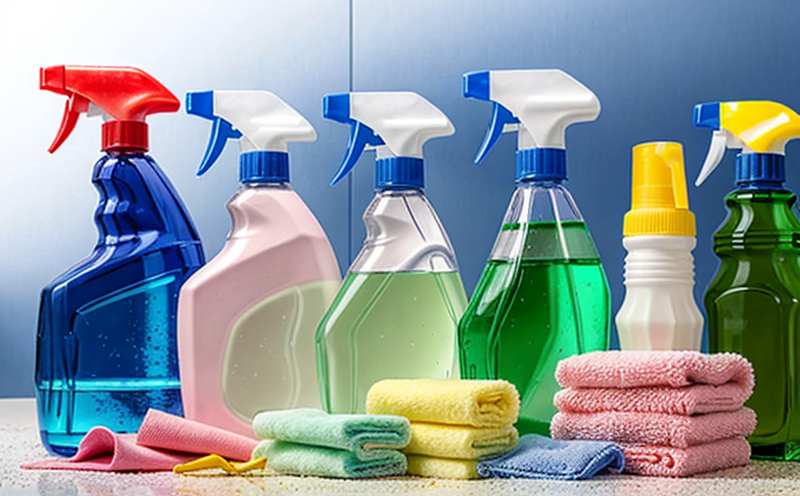Microbiological Quality Testing of Detergents
The microbiological quality testing of detergents is a critical process for ensuring the safety and efficacy of cleaning products. This service involves the identification, quantification, and characterization of microorganisms present in detergents to guarantee that they meet regulatory standards and consumer expectations.
Detergents are formulated with a variety of ingredients designed to remove dirt, grease, and stains from surfaces. However, these formulations can also serve as a medium for microbial growth if not properly controlled during manufacturing and subsequent use. Microbiological quality testing helps prevent this by ensuring that the detergent does not pose any health risks to consumers.
The first step in microbiological quality testing is specimen preparation. This involves taking representative samples from different batches or lots of the detergent being tested. The samples must be handled carefully to avoid contamination, as even minor changes can affect the test results. Once prepared, these specimens undergo a series of tests aimed at detecting and quantifying various types of microorganisms.
The testing process typically includes several stages:
- Pathogen Detection: Screening for known pathogens that could cause illness or infection if present in the detergent. Common pathogens include Salmonella, Listeria monocytogenes, and Escherichia coli (E. coli).
- Total Plate Count (TPC): Measuring the total number of viable microorganisms on a given surface area.
- Coliform Testing: Detecting coliform bacteria as indicators of contamination from human or animal waste, which can suggest poor hygiene practices in manufacturing.
- Fungi and Yeast Count: Quantifying molds and yeasts that could impact the shelf life and effectiveness of the detergent.
Each stage requires specific laboratory techniques and equipment. For instance, agar plating is used for TPC while selective media are employed in pathogen detection. Advanced microbiological testing methods like polymerase chain reaction (PCR) or mass spectrometry can also be utilized where higher specificity is required.
The results of these tests provide detailed insights into the microbial load and composition within the detergent. These findings are then used to assess compliance with relevant international standards such as ISO 16642, which provides guidelines for microbiological quality in cleaning agents.
Environmental and sustainability contributions through microbiological testing extend beyond mere safety assurance. By identifying potential sources of contamination early, manufacturers can implement corrective measures promptly, reducing waste generation and environmental impact associated with substandard products reaching the market.
Applied Standards
The microbiological quality testing of detergents adheres to several internationally recognized standards that ensure accuracy and consistency across different laboratories. One key standard is ISO 16642, which specifies methods for determining the microbiological quality in cleaning agents.
This standard outlines procedures for sampling, sample preparation, analytical techniques, and interpretation of results. It covers various aspects including total plate count, coliform groups, indicator organisms, and pathogenic bacteria.
ASTM D7462 is another important document that provides additional guidance on testing specific types of cleaning products. This standard addresses the microbiological aspects relevant to hard surface cleaners and related formulations.
The European Union also has its own set of directives and recommendations regarding product safety, particularly in relation to hygiene and health concerns associated with cleaning agents. Compliance with these regulations ensures that detergents are fit for purpose and pose no undue risk to users.
Environmental and Sustainability Contributions
The microbiological quality testing of detergents plays a crucial role in promoting environmental sustainability by minimizing the release of harmful microorganisms into the environment. Effective testing helps manufacturers maintain high standards of hygiene throughout production processes, thereby reducing the likelihood of contaminated products reaching consumers.
- Reduction of Contamination Risk: By ensuring that detergents do not contain excessive levels of pathogenic microbes, this service reduces the risk of cross-contamination during household cleaning activities. This is particularly important in healthcare settings where hygiene standards are paramount.
- Enhanced Consumer Confidence: Consumers can trust that products labeled as safe and effective have undergone rigorous testing to confirm their microbiological quality. This builds brand loyalty and enhances market reputation for companies adhering to strict safety protocols.
- Resource Efficiency: Detecting and addressing microbial issues promptly allows manufacturers to optimize resource usage, from raw materials selection to final product formulation. Efficient production processes contribute positively towards overall sustainability goals.
Moreover, by incorporating sustainable practices into their operations, laboratories offering microbiological testing services also contribute significantly to broader environmental initiatives. These efforts include minimizing waste generation through efficient sampling methods and proper disposal of hazardous substances used during analysis.
Use Cases and Application Examples
The application of microbiological quality testing in the detergent industry spans multiple sectors, including household cleaning products, industrial chemicals, and personal care items. Here are some specific use cases:
- Household Detergents: Ensuring that everyday laundry detergents do not harbor harmful microorganisms is essential for maintaining good hygiene practices at home.
- Institutional Cleaners: Schools, hospitals, and other institutions rely on effective cleaning agents to prevent the spread of infectious diseases. Microbiological testing ensures these products meet stringent hygiene requirements.
- Laundry Services: Professional laundry services need reliable microbiological quality testing to provide clean textiles free from pathogens, enhancing customer satisfaction while protecting public health.
In addition to consumer goods, industrial applications also benefit greatly from this service. For example:
- Textile Mills: Microbiological quality testing helps textile mills maintain strict hygiene standards during processing, ensuring fabric remains safe for end users.
- Petrochemical Plants: In environments where chemicals interact with biological materials, monitoring microbial growth can prevent costly equipment failures and environmental pollution.
These diverse applications underscore the importance of microbiological quality testing in safeguarding public health and protecting the environment across various industries.





